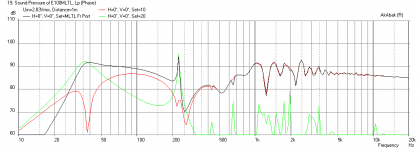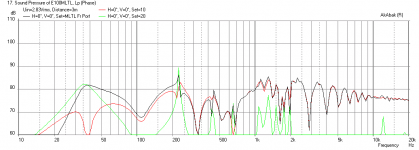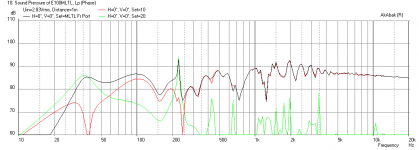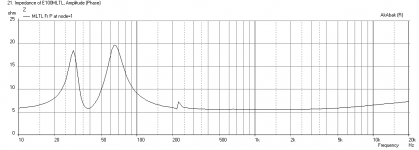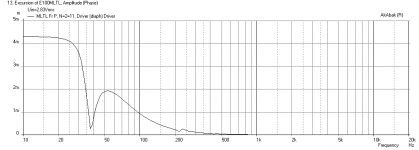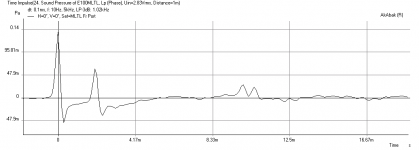Hi,
I always wanted to have a Jordan speaker home, the JX92s was my goal, but
until I was able to get one, they have changed to be produced by EAD.
I bought the E100HD, and as a enclosure I have chosen the 31" MLTL (30Hz) Compact Design
http://www.eadsweden.com/shop/17596/art77/16148377-d4c805-E100-31-MLTL-MD.pdf
Designed by M.J.King for Jordan US.
Here are some pictures from the work:




Has anyone else build it? any experience to share, looking forward especially regarding the stuffing?
I made the mechanical part almost, and tried it just in the MDF enclosure, I´m very positive surprised by the driver, I´m really looking forward to finish them.
I will keep you updated on the build.
The material to build them incl MDF is about 400EUR.
I always wanted to have a Jordan speaker home, the JX92s was my goal, but
until I was able to get one, they have changed to be produced by EAD.
I bought the E100HD, and as a enclosure I have chosen the 31" MLTL (30Hz) Compact Design
http://www.eadsweden.com/shop/17596/art77/16148377-d4c805-E100-31-MLTL-MD.pdf
Designed by M.J.King for Jordan US.
Here are some pictures from the work:




Has anyone else build it? any experience to share, looking forward especially regarding the stuffing?
I made the mechanical part almost, and tried it just in the MDF enclosure, I´m very positive surprised by the driver, I´m really looking forward to finish them.
I will keep you updated on the build.
The material to build them incl MDF is about 400EUR.
Greets!
Haven't auditioned this driver or JX92S in this cab alignment, so can’t comment on how it performs, but it needs to be at least twice as big [WxD area doubles] to get a ‘close enough’ response plot to the one shown on the cab drawing. Also, your ‘doughnut hole’ braces are restrictive enough that I doubt there’s much ¼ WL TL action to damp the vent, i.e. acting more like a simple bass reflex.
Not implying it won’t perform well in your system since in a sim it has a very SET tube-like response, just not as the designer intended.
GM
Haven't auditioned this driver or JX92S in this cab alignment, so can’t comment on how it performs, but it needs to be at least twice as big [WxD area doubles] to get a ‘close enough’ response plot to the one shown on the cab drawing. Also, your ‘doughnut hole’ braces are restrictive enough that I doubt there’s much ¼ WL TL action to damp the vent, i.e. acting more like a simple bass reflex.
Not implying it won’t perform well in your system since in a sim it has a very SET tube-like response, just not as the designer intended.
GM
Attachments
OK that might be a issue the bracing was given at best intention it is 2x 18mm with a 150mm cyrcle cut out.
I might cut it completely out, althou the simulation looks nice as well, but not to 30Hz but only 40hz...
Regarding the driver, since I can not compare it, I can not tell, but EAD made the last jordans, so the E100HD should be a improved Jordan and should work well in Jordan designed enclosures. After I will be done, I can put some measurements.
I might cut it completely out, althou the simulation looks nice as well, but not to 30Hz but only 40hz...
Regarding the driver, since I can not compare it, I can not tell, but EAD made the last jordans, so the E100HD should be a improved Jordan and should work well in Jordan designed enclosures. After I will be done, I can put some measurements.
Sim of 31 inch MLTL for E100HD
I ran a simulation of the 31 inch MLTL with dimensions as provided by EAD (without the donut baffles). GM is correct, the tuning frequency is about 40 Hz (maybe 37 Hz). There is no damping in AkAbak so you will see sharp peaks and dips, but broad features are probably going to show up. One thing to be careful with this speaker, as with most speakers is the placement in the room - it can really have an impact on big dips as you can see. The first plot is the freq response at 1 m away with the speaker placed flush against a wall so that you essentially have no baffle step loss. The second plot is a 'typical' placement of 24 in from a back wall and measurement at a typical listening position 3 m away - not the large dips due to room suck-out. The third plot shows the speaker 60 in away from a back wall to remove wall effect and measurement at 1 m - here the baffle step loss suggests that a BSC should be used to balance things out. Fourth plot is impedance, fifth plot is cone displacement, and sixth plot is impulse response (60 in away from wall, 1 m measurement). One thing is clear though, this box does not look like it was optimized for the E100HD driver.
I ran a simulation of the 31 inch MLTL with dimensions as provided by EAD (without the donut baffles). GM is correct, the tuning frequency is about 40 Hz (maybe 37 Hz). There is no damping in AkAbak so you will see sharp peaks and dips, but broad features are probably going to show up. One thing to be careful with this speaker, as with most speakers is the placement in the room - it can really have an impact on big dips as you can see. The first plot is the freq response at 1 m away with the speaker placed flush against a wall so that you essentially have no baffle step loss. The second plot is a 'typical' placement of 24 in from a back wall and measurement at a typical listening position 3 m away - not the large dips due to room suck-out. The third plot shows the speaker 60 in away from a back wall to remove wall effect and measurement at 1 m - here the baffle step loss suggests that a BSC should be used to balance things out. Fourth plot is impedance, fifth plot is cone displacement, and sixth plot is impulse response (60 in away from wall, 1 m measurement). One thing is clear though, this box does not look like it was optimized for the E100HD driver.
Attachments
Thanks a lot for the simulations, I really appriciate that 
From what I see, I would have no issue in general, but what is happening between 100Hz
and 1Khz is not satisfying.
The enclosure is now done, so I can just take out the bracings, play a bit with stuffing and adjust the bassreflex.
I´m open to suggestions
I have not imagined it will be that much of a difference since EAD did manufacture the Jordan 92 in past.
From what I see, I would have no issue in general, but what is happening between 100Hz
and 1Khz is not satisfying.
The enclosure is now done, so I can just take out the bracings, play a bit with stuffing and adjust the bassreflex.
I´m open to suggestions
I have not imagined it will be that much of a difference since EAD did manufacture the Jordan 92 in past.
Yes, but unfortunately, as soon as they change the driver, that means the boxes really need to be changed too, assuming you want the same basic alignment. As noted, it'll still work, just not as originally intended.
GM's comparative simulation will be the more accurate reference point to the cabinet's actual behaviour since it does account for damping material, which will kill much of the unwanted harmonic resonances you see in X's akabak plots.
As an aside, don't forget that under practical conditions especially < 300Hz, the room almost completely dominates in terms of dimensions, construction, furnishings & the speaker position within it, so you're never going to get a perfect response. Fortunately our hearing acuity falls rapidly in the lower registers, so it usually looks worse on paper than it actually sounds.
GM's comparative simulation will be the more accurate reference point to the cabinet's actual behaviour since it does account for damping material, which will kill much of the unwanted harmonic resonances you see in X's akabak plots.
As an aside, don't forget that under practical conditions especially < 300Hz, the room almost completely dominates in terms of dimensions, construction, furnishings & the speaker position within it, so you're never going to get a perfect response. Fortunately our hearing acuity falls rapidly in the lower registers, so it usually looks worse on paper than it actually sounds.
hello just a brief update, I have no measuring equipment right now at hand but, i can tell the speaker starts at 25hz, I have installed ARTA and measured just with my laptop(internal card), freq bellow 500hz are by 10db too low, but I measured in a unsuitable room. and conditions, so no conclusion is possible, but the measurement shows a drop down at cca 180hz, almost like the simulation abowe. Any ideas how to compensate?
Greets!
Assuming you don't want to use any more EQ than necessary, then to combat the rising HF above ~500 Hz, toe them in ~30 deg and fine tune the angle if required.
The sims assumes a 2pi space loading, i.e. buried flush in a large, flat field with the mic suspended overhead, so the drop below ~180 Hz is normally either dealt with by placing them up against a wall or near a corner; otherwise, a BSC filter is required:
http://www.quarter-wave.com/General/BSC_MathCad.pdf
http://www.quarter-wave.com/General/BSC_Variable.pdf
http://www.quarter-wave.com/General/BSC_Calculator.xls
Loudspeaker Diffraction Loss and Baffle Step Compensation Circuits
GM
Assuming you don't want to use any more EQ than necessary, then to combat the rising HF above ~500 Hz, toe them in ~30 deg and fine tune the angle if required.
The sims assumes a 2pi space loading, i.e. buried flush in a large, flat field with the mic suspended overhead, so the drop below ~180 Hz is normally either dealt with by placing them up against a wall or near a corner; otherwise, a BSC filter is required:
http://www.quarter-wave.com/General/BSC_MathCad.pdf
http://www.quarter-wave.com/General/BSC_Variable.pdf
http://www.quarter-wave.com/General/BSC_Calculator.xls
Loudspeaker Diffraction Loss and Baffle Step Compensation Circuits
GM
The main idea is to have non passive component if possible. But thanks for the links, the variable bufferstep looks interesting 
What about placing the speakers higher, they not much taller than a big bookshelf speaker, so a elevation of cca 0,5meter might be acceptable. Still I measured without damping material and without a glued front pannel so that might do some change as well.
What about placing the speakers higher, they not much taller than a big bookshelf speaker, so a elevation of cca 0,5meter might be acceptable. Still I measured without damping material and without a glued front pannel so that might do some change as well.
Putting them on stands won't bring any improvements since baffle-step losses are linked to the physical dimensions (& especially width) of the cabinet. If you have a narrow-band notch between ~100Hz - 200Hz, that's likely to be floor-bounce (cancellation from the driver's reflected image on the floor), so the frequency of this will vary depending on height.
Having a properly sealed box is a must, and you'll need damping in the enclosures since this is a functional part of their operation. It should smooth out unwanted harmonic resonances. But it won't help with step-loss either.
Having a properly sealed box is a must, and you'll need damping in the enclosures since this is a functional part of their operation. It should smooth out unwanted harmonic resonances. But it won't help with step-loss either.
OK I should be in 2-2 weeks back in Prague and there is a room and equipment to measure it precisely.
Regarding the damping, the Angelhair is on its way, and I have to experiment with that, as well I might have to change the bassreflex dimensions since I dont get here the 52mm bassreflex, instead of that I get a 50mm, but I dont believe that will even make a measurable difference.
I will paint he enclosure today, and will keep you updated, since I believe the E100 is a really good speaker
Regarding the damping, the Angelhair is on its way, and I have to experiment with that, as well I might have to change the bassreflex dimensions since I dont get here the 52mm bassreflex, instead of that I get a 50mm, but I dont believe that will even make a measurable difference.
I will paint he enclosure today, and will keep you updated, since I believe the E100 is a really good speaker
The main idea is to have non passive component if possible. But thanks for the links, the variable bufferstep looks interesting
What about placing the speakers higher, they not much taller than a big bookshelf speaker, so a elevation of cca 0,5meter might be acceptable. Still I measured without damping material and without a glued front pannel so that might do some change as well.
You’re welcome!
Yeah, adding passives to already low efficiency speakers isn’t my first choice either.
I prefer tall speakers and why the original 31” Jordan MLTL has the vent in the bottom, ‘firing’ into an extension cavity with a floor deflector angled to acoustically add a short parabolic flare to it.
Hmm, did you mean the dashed blue line in the sim? If so, then odds are there’s an air leak, presumably due to the baffle just being clamped on, though even just air leaks around coarse machine screw threads has proven to be enough to negate much of a BR’s, and especially a TL variant’s, vent gain.
OK I should be in 2-2 weeks back in Prague and there is a room and equipment to measure it precisely.
Regarding the damping, the Angelhair is on its way, and I have to experiment with that, as well I might have to change the bassreflex dimensions since I dont get here the 52mm bassreflex, instead of that I get a 50mm, but I dont believe that will even make a measurable difference.
I will paint he enclosure today, and will keep you updated, since I believe the E100 is a really good speaker
No, 2 mm probably isn’t even measurable at any reasonable resolution, much less audible.
GM
If you have a narrow-band notch between ~100Hz - 200Hz, that's likely to be floor-bounce (cancellation from the driver's reflected image on the floor)......
FWIW, historically, ‘floor bounce’ refers to the one that occurs between the speaker and listening position [LP], so it’s calculated using driver/floor and LP height over distance from the speaker; the one between the speaker/floor is just one of the speaker’s many eigenmodes.
In both cases, either the driver needs to be near/at the floor or up high enough to push its frequency low enough to get ‘lost’/blended in the room’s eigenmodes where our hearing acuity isn’t good enough to obviously notice it and if one can place it where’s some room gain to offset it, so much the better.
That, or tilt the baffle back > 6 degs to turn it into a smoothly decaying ‘echo’ with of course the loss of any floor 2pi gain as the trade-off.
In a similar vein, I see a lot of folks have some sort of coffee table between the speaker, LP, but this early ‘floor’ reflection typically wreaks havoc with a system’s perceived ‘stereo’ effects, often much more so than early side wall reflections, so for serious listening one should at least cover it with a very absorptive bed comforter or acoustic blanket and for sure have it behind the LP or out of the room when ‘voicing’ a sound system.
GM
Hi,
I painted the enclosure, black and white works well:
http://hex.dan.sweb.cz/EADE100HD/2013-07-20 13.58.53.jpg
http://hex.dan.sweb.cz/EADE100HD/2013-07-20 13.59.04.jpg
http://hex.dan.sweb.cz/EADE100HD/2013-07-21 20.25.14.jpg
I reduced the Bassrelex to the recommended size and remesuared with 10Watt input, the downpeak at 16OHz is gone.
It is still not ideal, but the damping is not yeat final, as well as the front panel is still open for further adjustments, and the inside wire is stil crocodile connection.
But one thing is astonishing the space effect is so plastical, I heard a lot of fullrange speakers, but this one is really the top in the plasticity of the space and sound.
I will keep you updated with further progress
I painted the enclosure, black and white works well:
http://hex.dan.sweb.cz/EADE100HD/2013-07-20 13.58.53.jpg
http://hex.dan.sweb.cz/EADE100HD/2013-07-20 13.59.04.jpg
http://hex.dan.sweb.cz/EADE100HD/2013-07-21 20.25.14.jpg
I reduced the Bassrelex to the recommended size and remesuared with 10Watt input, the downpeak at 16OHz is gone.
It is still not ideal, but the damping is not yeat final, as well as the front panel is still open for further adjustments, and the inside wire is stil crocodile connection.
But one thing is astonishing the space effect is so plastical, I heard a lot of fullrange speakers, but this one is really the top in the plasticity of the space and sound.
I will keep you updated with further progress
I reduced the Bassrelex to the recommended size
?? Reduced what?
GM
- Status
- This old topic is closed. If you want to reopen this topic, contact a moderator using the "Report Post" button.
- Home
- Loudspeakers
- Full Range
- EAD E100HD in Jordan 31" MLTL (30Hz) Compact Design
![EAD100 v1.1 31' MLTL [MD].gif](/community/data/attachments/323/323844-fc77ae1fbc2b09335bed23d77a82d099.jpg)
![EAD100 v1.1 31' MLTL [MD] optimized.gif](/community/data/attachments/323/323848-f6e1554e62765c1c316d4ea19467ff39.jpg)
